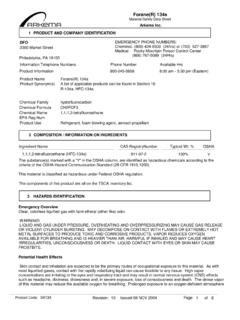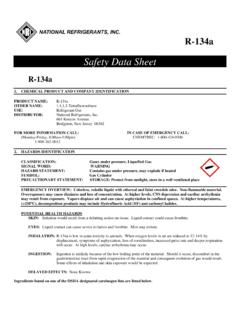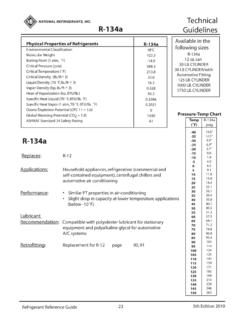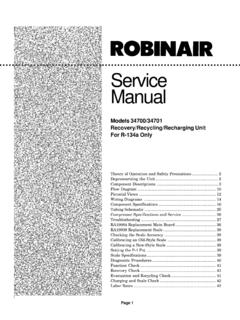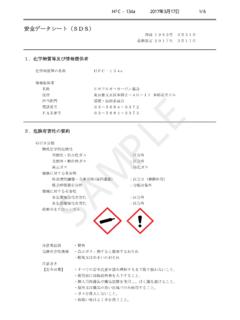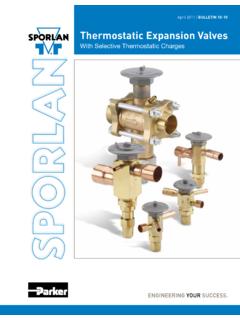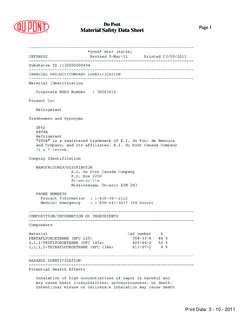Transcription of AC–1 AIR CONDITIONING SYSTEM - Turboninjas.com
1 AIR CONDITIONING SYSTEM AIR CONDITIONING SYSTEMAC 1 PRECAUTIONS FOR SERVICING R134a AIRCONDITIONERS1. USE OF NEW REFRIGERANT R134aThe very different characteristics of refrigerantsR134a and R12 have determined the design of theirrespective air CONDITIONING systems. Under no circum stances allow R12 to enter an R134a SYSTEM , or viceversa, because serious damage could DESCRIPTIONNEW AIR CONDITIONING SYSTEM WITHR134aRefrigerant R12 (CFC12), previously used in automo biles air CONDITIONING systems is believed to contributetowards the depletion the earth s ozone layer. Theozone layer help to protect us against the harmfulultraviolet rays of the USE OF PROPER COMPRESSOR OILC ompressor oil used in conventional R12 air condi tioning systems cannot be used in R 134a air condi tioning use genuine Toyota R1 34a air CONDITIONING oilN D OIL 8, made expressly for use with R 1 even a small amount of the wrong oil is changed, itwill result in clouding of the large amount will cause the compressor to seize newly developed refrigerant, R134 a (HFC 134 a),does not the destroy the ozone layer.
2 AIR CONDITIONING SYSTEMGENERAL DESCRIPTIONAC 24. TIGHTEN CONNECTING PARTS SECURELYS ecurely tighten the connecting parts to prevent leak ing of refrigerant a few drops of compressor oil to 0 ringfittings for easy tightening and to prevent leakingof refrigerant : Apply only ND OIL 8 compressor oilTighten the nuts using 2 wrenches to avoid twist ing the the 0 ring fittings or the bolted typefittings to the specified INSERT PLUG IMMEDIATELY IN DISCONNECTEDPARTSI nsert a plug immediately in the disconnected parts toprevent the ingress of moisture and DO NOT REMOVE PLUG FROM NEW PARTS UNTILIMMEDIATELY BEFORE INSTALLATION3. USE OF PROPER O RINGS AND SEALS0 rings and seals used for conventional R12 airconditioning systams cannot be used for R134a airconditioning use genuine Toyota R 134a SYSTEM 0 ringsand seals for R 1 34a air CONDITIONING DISCHARGE GAS IN NEW COMPRESSOR FROMCHARGING VALVE BEFORE INSTALLING ITIf the gas in the new compressor is not dischargedfirst, compressor oil will spray out with gas when theplug is O rings and/or seals for R1 2 air CONDITIONING sys tems are used by mistake in the connections of an R134a air CONDITIONING SYSTEM , the O ring and sealswill foam and swell resulting in leakage of refrigerant.
3 AIR CONDITIONING SYSTEMGENERAL DESCRIPTIONAC 33. USE VACUUM PUMP ADAPTERBy connecting a vacuum pump adapter, the vacuumpump can be used for both R 134a and R 12 air condi tioning vacuum pump adaptor has an internal evacuation is completed and the vacuum pumpswitch is turned off, the magnetic valve opens allow ing the introduction atmospheric air into the manifoldgauges to prevent the back flow of oil from thevacuum pump into the gauge :Be sure to turn off the manifold gauge valve immediatelyafter evacuating the SYSTEM . Then you may switch offthe vacuum pump. If this order is reversed, the line willbe temporarily open to TOOLS FOR R134a AIRCONDITIONERWhen servicing R134a air CONDITIONING systemsalways use the R134a dedicated manifold gauges, gasleak detector and vacuum pump USE MANIFOLD GAUGES FOR R134a AIR CONDITI ONERA lways use R134a dedicated manifold gauges to pre vent R1 2 and RI 2 compressor oil contaminating the R134a USE R134a GAS LEAK DETECTORS imilarly, always use an R 134a dedicated leak detec tor.
4 The R1 2 leak detector is not sufficiently sensitive. AIR CONDITIONING SYSTEMGENERAL DESCRIPTIONAC 43. BE CAREFUL THAT LIQUID REFRIGERANT DOESNOT GET IN YOUR EYES OR ON YOUR SKINIf liquid refrigerant gets in your eyes or on your skin:(a) Wash the area with lots of cool : Do not rub your eyes or skin.(b) Apply clean petroleum jelly to the skin.(c) GO immediately to a physician or hospital for profes sional PRECAUTIONS FORREFRIGERANT CONTAINER1. NEVER HEAT CONTAINER OR EXPOSE IT TONAKED FLAME2. BE CAREFUL NOT TO DROP CONTAINER AND NOTTO APPLY PHYSICAL SHOCKS TO ITHANDLING PRECAUTIONS FORREFRIGERANT1. DO NOT HANDLE REFRIGERANT IN AN ENCLOSEDAREA OR NEAR AN OPEN FLAME2. ALWAYS WEAR EYE PROTECTIONCHARGING AND LEAK CHECK METHODSE vacuate the refrigeration SYSTEM according to thefollowing refrigerant in gas state untilgauge pressure reads 1 kglcm2 Abnormal indication ofmanifold gaugesCheck and correctpipe jointsRefrigerantChargeRefrigerantCharge StartEvacuationStopEvacuationLeave for 5 LeakCheckAirtightCheck10 min.
5 AIR CONDITIONING SYSTEMGENERAL DESCRIPTIONAC 5 CAUTION: Be sure to connect both the high and low pressurequick connectors onto the A/C SYSTEM when eva cuating. If only one side is connected, the systemwould be open to atmosphere through the otherconnector, making it impossible to maintainvacuum. Be sure to turn off the manifold gauge valve imme diately after evacuating the SYSTEM . Then you mayswitch off the vacuum WHEN CHARGINGREFRIGERANT1. DO NOT OPERATE COMPRESSOR WITHOUTENOUGH REFRIGERANT IN REFRIGERANTSYSTEMIf there is not enough refrigerant in the refrigerantsystem oil lubrication will be insufficient and compres sor burnout may occur, so take care to avoid DO NOT OPEN HIGH PRESSURE MANIFOLD VALVEWHILST COMPRESSOR IS OPERATINGIf the high pressure valve is opened, refrigerant flowsin the reverse direction and could cause the chargingcylinder to rupture, so open and close the low pres sure valve BE CAREFUL NOT TO OVERCHARGE WITH RE FRIGERANT IN SYSTEMIf refrigerant is overcharged, it causes problems suchas insufficient cooling, poor fuel economy, engineoverheating PARTSB efore removing and inspecting the electrical parts,set the ignition switch to the LOCK position anddisconnect the negative ( ) terminal cable from bat.
6 Work must be started after 90 seconds fromthe time the Ignition switch is turned to the LOCK position and the negative ( ) terminal cable is discon nected from the battery. AIR CONDITIONING SYSTEMGENERAL DESCRIPTIONAC 6 SUPPLEMENTAL RESTRAINT SYSTEM (SRS)Failure to carry out service operations in the correctsequence could cause the supplemental restraintsystem to deploy, possibly leading to a serious acci removal or installation of the parts and theyellow wire harness and connector for the airbag isnecessary, refer to the precautionary notices in the RSsection before performing the : Work must be started after 90 seconds fromthe time the ignition switch is turned to the LOCK position and the negative ( ) terminal cable is discon nected from the battery. AIR CONDITIONING SYSTEMGENERAL DESCRIPTIONAC 7 DESCRIPTIONPARTS LOCATION AIR CONDITIONING SYSTEMDESCRIPTIONAC 8 AIR CONDITIONING SYSTEMDESCRIPTIONAC 9 ELECTRICAL WIRING DIAGRAM(Lever Type On 5S FE Engine Model) AIR CONDITIONING SYSTEMDESCRIPTIONAC 10 AIR CONDITIONING SYSTEMDESCRIPTIONAC 11(Push Button Type On 5S FE Engine Model) AIR CONDITIONING SYSTEMDESCRIPTIONAC 12 AIR CONDITIONING SYSTEMDESCRIPTIONAC 13(Lever Type On 1 MZ FE Engine Model) AIR CONDITIONING SYSTEMDESCRIPTIONAC 14 AIR CONDITIONING SYSTEMDESCRIPTIONAC 15(Push Button Type On 1 MZ FE Engine Model) AIR CONDITIONING SYSTEMDESCRIPTIONAC 16 AIR CONDITIONING SYSTEMDESCRIPTIONAC 17 DAMPERS POSITION AIR CONDITIONING SYSTEMDESCRIPTIONAC 18 PREPARATIONSST (SPECIAL SERVICE TOOLS)(07117 58070) T Joint(07117 78050) Refrigerant Charging Gauge(07117 58080)
7 Quick Coupler(07117 88070) Refrigerant Charging Hose(07117 58090) Quick Coupler(07117 88060) Refrigerant Charging Hose(07117 88080) Refrigerant Charging Nose(07117 58060) Refrigerant Drain Service ValveSuction (diam. 13 mm)Discharge (diam. 16 mm)Suction (Blue)Discharge (Red)Utility (Green)07116 38360 Gas Leak Detector Assembly07110 58060 Air Conditioner Service Tool Set07112 66040 Magnetic Clutch Remover07112 76060 Magnetic Clutch Stopper07114 84020 Snap Ring Pliers AIR CONDITIONING SYSTEMPREPARATIONAC 19 RECOMMENDED TOOL09082 00050 TOYOTA Electrical Tester SetWhen replacing compressorWhen replacing evaporatorWhen replacing condenserND OIL 8 or equivalentWhen replacing receiverLUBRICANT10 cc ( )140 cc ( )40 cc ( )40 cc ( f )Compressor oilClassificationCapacityItem AIR CONDITIONING SYSTEMPREPARATIONAC 20 USE OF MANIFOLD GAUGE SETMANIFOLD GAUGE SET INSTALLATION1.
8 CONNECT CHARGING HOSES TO MANIFOLDGAUGE SETT ighten the nuts by : Do not connect the wrong CONNECT QUICK CONNECTORS TO CHARGINGHOSEST ighten the nuts by CLOSE BOTH HAND VALVES OF MANIFOLDGAUGE SET4. REMOVE CAPS FROM SERVICE VALVES ON RE FRIGERANT LINEMANIFOLD GAUGE SET REMOVAL1. CLOSE BOTH HAND VALVES OF MANIFOLDGAUGE SET2. DISCONNECT QUICK CONNECTORS FROM SER VICE VALVES ON REFRIGERANT LINEHINT: Slide the sleeve of the quick connector upwardto unlock the connector and remove it from the ser vice INSTALL CAPS TO SERVICE VALVES ON REFRIG ERANT LINE5. CONNECT QUICK CONNECTORS TO SERVICEVALVESHINT: Push the quick connector onto the servicevalve, then slide the sleeve of the quick connectordownward to lock it. AIR CONDITIONING SYSTEMUSE OF MANIFOLD GAUGE SETAC 21 TROUBLESHOOTINGUse the table below to help you find the cause of problem.
9 The numbers indicate the priority ofthe likely cause of the problem. Check each rt in order. If necessary, replace these RefrigerationSystem with Manifold Gauge SetCool air comes out only at highengine speedNo engine idle up when A/Cswitch onAir temp. control not functioningCool air comes out intermittentlyInspect Volume of RefrigerantRevolution Detecting SensorInsufficient flow of warm airInspect Drive Belt TensionInsufficient flow of cool airNo air flow mode controlEvaporator Temp. SensorNo warm air comes outMagnet Clutch RelayNo cool air comes outNo blower operationInsufficient coolingNo air inlet controlNo blower controlA/C Fan RelaysPressure SwitchFuse (A/C)Fusible LinkPartsNameSee pageTroubleAC 60AC 30AC 24AC 64AC 63AC 62AC 63AC 29 AIR CONDITIONING SYSTEMTROUBLESHOOTINGAC 22 Wiring or Wiring ConnectionExpansion Valve (Replace)A/C Control AssemblyAir out let ServomotorCondenser Fan MotorAir Inlet ServomotorMagnet ClutchBlower ResistorA/C AmplifierBlower MotorCompressorEvaporatorCondenserReceiv erAC 57AC 58AC 47AC 67AC 49AC 45AC 53AC 56AC 66AC 55AC 36AC 36AC 59 AIR CONDITIONING SYSTEMTROUBLESHOOTINGAC 23 REFRIGERANT SYSTEM INSPECTION WITH MANIFOLD GAUGE SETThis is a method in which the trouble is located by using a manifold gauge set.
10 (See USE OF MANIFOLD GAUGE SET on page AC 21)Read the manifold gauge pressure when the following conditions are established:(a) Temperature at the air inlet with the switch set at RECIRC is 30 35 C (86 95 F)(b) Engine running at 1,500 rpm(c) Blower speed control switch set at high(d) Temperature control set at max. coolHINT: It should be noted that the gauge indications may vary slightly due to ambient NORMALLY FUNCTIONING REFRIGERATION SYSTEMG auge reading:Low pressure MPa ( kgf/cm )High pressure MPa (14 16 kgf/emt) AIR CONDITIONING SYSTEMTROUBLESHOOTINGAC 24(1) Check for gas leakagewith leak detector andrepair if necessary(2) Charge refrigerant toproper arhount(3) If pressure indicatedvalue is near 0 whenconnected to gauge,create the vacuum af ter inspecting and re pairing the location ofthe leak Drier in oversaturatedstate Moisture in refrigerationsystem freezes at expan sion valve orifice andblocks circulation of re frigerant Moisture entered in re frigeration systemfreezes at expansionvalve orifice and tempo rarily stops cycle, butnormal state is restoredafter a time when the icemelts(1) Replace receiver/drier(2) Remove moisture incycle through repeat edly evacuating air(3)
